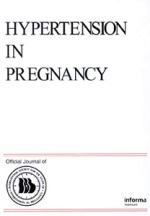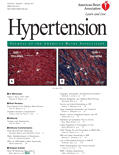
Hypertension, also known as high blood pressure (HBP), is a long-term medical condition in which the blood pressure in the arteries is persistently elevated. High blood pressure usually does not cause symptoms. Long-term high blood pressure, however, is a major risk factor for stroke, coronary artery disease, heart failure, atrial fibrillation, peripheral arterial disease, vision loss, chronic kidney disease, and dementia.

Hypertensive retinopathy is damage to the retina and retinal circulation due to high blood pressure.

Angiotensin II receptor blockers (ARBs), formally angiotensin II receptor type 1 (AT1) antagonists, also known as angiotensin receptor blockers, angiotensin II receptor antagonists, or AT1 receptor antagonists, are a group of pharmaceuticals that bind to and inhibit the angiotensin II receptor type 1 (AT1) and thereby block the arteriolar contraction and sodium retention effects of renin–angiotensin system.
Essential hypertension is the form of hypertension that by definition has no identifiable secondary cause. It is the most common type affecting 85% of those with high blood pressure. The remaining 15% is accounted for by various causes of secondary hypertension. Primary hypertension tends to be familial and is likely to be the consequence of an interaction between environmental and genetic factors. Prevalence of essential hypertension increases with age, and individuals with relatively high blood pressure at younger ages are at increased risk for the subsequent development of hypertension. Hypertension can increase the risk of cerebral, cardiac, and renal events.
Hepatosplenomegaly is the simultaneous enlargement of both the liver (hepatomegaly) and the spleen (splenomegaly). Hepatosplenomegaly can occur as the result of acute viral hepatitis, infectious mononucleosis, and histoplasmosis or it can be the sign of a serious and life-threatening lysosomal storage disease. Systemic venous hypertension can also increase the risk for developing hepatosplenomegaly, which may be seen in those patients with right-sided heart failure.
Secondary hypertension is a type of hypertension which by definition is caused by an identifiable underlying primary cause. It is much less common than the other type, called essential hypertension, affecting only 5-10% of hypertensive patients. It has many different causes including endocrine diseases, kidney diseases, and tumors. It also can be a side effect of many medications.

Levomethamphetamine is the levorotatory (L-enantiomer) form of methamphetamine. Levomethamphetamine is a sympathomimetic vasoconstrictor that is the active ingredient in some over-the-counter (OTC) nasal decongestant inhalers in the United States.

Evolution and Human Behavior is a bimonthly peer-reviewed academic journal covering research in which evolutionary perspectives are brought to bear on the study of human behavior, ranging from evolutionary psychology to evolutionary anthropology and cultural evolution. It is primarily a scientific journal, but articles from scholars in the humanities are also published. Papers reporting on theoretical and empirical work on other species may be included if their relevance to the human animal is apparent. The journal was established in 1980, and beginning with Volume 18 in 1997 has been published by Elsevier on behalf of the Human Behavior and Evolution Society. The editor-in-chief is Debra Lieberman.

The European Journal of Human Genetics is a monthly peer-reviewed scientific journal published by the Nature Publishing Group on behalf of the European Society of Human Genetics. It covers all aspects of human genetics.
Aortopulmonary window (APW) refers to a congenital heart defect similar in some ways to persistent truncus arteriosus. Persistent truncus arteriosus involves a single valve; aortopulmonary window is a septal defect.
Cell Metabolism, launched in January 2005, is one of the newer titles in the Cell Press family. The journal focuses on physiology, with an emphasis on understanding the molecular basis of how the body self-regulates in the face of change, and how disturbances in these balances can lead to disease. Advances in these fields take on a special importance given the increasing prevalence of obesity, diabetes, hypertension, and related maladies in the developed world. Created in response to what top scientists saw as a growing need for a specialized journal in this field, Cell Metabolism is run by in-house editorial and production teams with full responsibility for selecting and preparing content for publication.

Clinical and Experimental Hypertension is a peer-reviewed medical journal that covers all aspects of human and animal hypertension. It was established in 1978 and is published by Taylor & Francis. The editor-in-chief is Mustafa F. Lokhandwala. According to the Journal Citation Reports, the journal has a 2014 impact factor of 1.234.

Journal of Hypertension is a peer-reviewed medical journal published by Lippincott Williams & Wilkins that was established in 1982. It is the official journal of the International Society of Hypertension and the European Society of Hypertension. The journal is published monthly and includes primary papers, reviews, special reports, and letters.

Hypertension in Pregnancy is a quarterly peer-reviewed medical journal covering human and animal hypertension during gestation, including the physiology of circulatory control, pathophysiology, methodology, and therapy. It is published by Informa and the editors-in-chief are Peter von Dadelszen (Canada) and Fiona Lyall (Scotland). According to the Journal Citation Reports, the journal has a 2013 impact factor of 1.192.

Atherosclerosis is a monthly peer-reviewed scientific journal established in 1970 and published by Elsevier. It is the official journal of the European Atherosclerosis Society and is affiliated with the International Atherosclerosis Society.

Hypertension is a monthly peer-reviewed scientific journal that was established in 1979. It is published on behalf of the American Heart Association by Lippincott Williams & Wilkins. The editor-in-chief is Anna F. Dominiczak. The journal publishes original manuscripts, invited review summaries, invited case-based reviews, recent study highlights, invited brief commentaries, scientific or technical tutorials, letters to the editor, and novel findings of unusual interest. It covers all aspects of research on hypertension, including pathophysiology, blood pressure regulation, clinical treatment, and prevention.

Salt consumption has been extensively studied for its role in human physiology and impact on human health. Chronic, high intake of dietary salt consumption is associated with hypertension and cardiovascular disease, in addition to other adverse health outcomes. Major health and scientific organizations, such as the World Health Organization, US Centers for Disease Control and Prevention, and American Heart Association, have established high salt consumption as a major risk factor for cardiovascular diseases and stroke.
The American Journal of Hypertension is a monthly peer-reviewed medical journal covering the field of cardiovascular medicine. It is published by Oxford University Press and the editor-in-chief is Michael H. Alderman. According to the Journal Citation Reports, the journal has a 2013 impact factor of 3.402, ranking it 20th out of 65 journals in the category "Peripheral Vascular Disease".
The Journal of the American Society of Hypertension was a monthly peer-reviewed medical journal covering hypertension. It was established in 2007 and was published until 2018 by Elsevier on behalf of the American Society of Hypertension, of which it was the official journal. The editor-in-chief was Daniel Levy. According to the Journal Citation Reports, the journal had a 2017 impact factor of 2.615.












